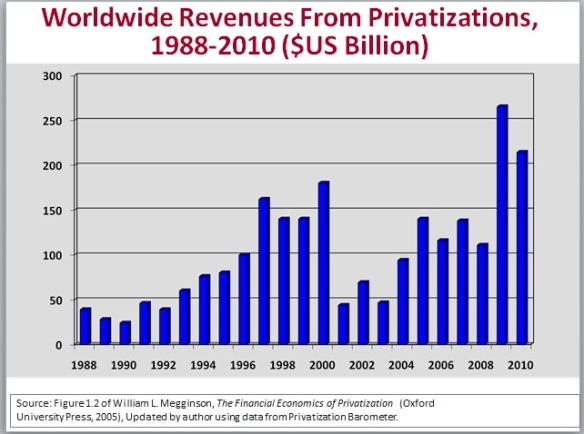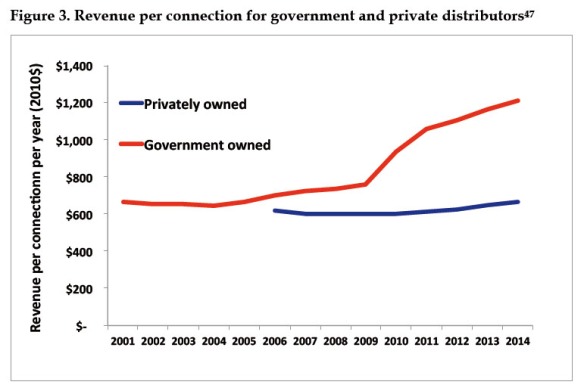Recently the Treasury released a December 2010 paper Short History of Post-Privatisation in New Zealand, written by John Wilson, an experienced former Treasury official.
It records in a balanced and objective way the history of nine major privatisations by central and local governments. The companies surveyed are Ports of Auckland, Bank of New Zealand, Air New Zealand, Auckland International Airport, Telecom, Tranz Rail, Trustpower, Contact Energy and the Forestry Corporation.
The paper notes that
The selection of companies was intended to illustrate the issues that have arisen from privatisation. The list of companies is not comprehensive, nor is it necessarily a sufficiently robustly drawn sample to draw strong aggregate conclusions about privatisation in New Zealand. The strongest general conclusions about the merits of private rather than government ownership can be drawn from global studies with much bigger samples.
Not covered are many of the other 20 plus privatisations that would generally be regarded as successful, such as NZ Steel, Petrocorp, Postbank, Rural Bank, State Insurance, Works Development Services and Capital Property Services.
The paper notes the range of objectives of privatisation of governments around the world:
- Putting businesses under the full pressures of private capital markets, and thus making them more efficient.
- Reducing the exposure of the government balance sheet to risky debt financed assets.
- Removing the capacity of the businesses to seek government aid in bad times, thus both promoting better business management (to avoid that risk) and reducing risks to government fiscal outcomes.
- Promoting the development of local capital markets, and/or encouraging a broad ownership of shares in the community.
- Using the sale proceeds for higher priorities, typically to reduce government debt.
All of these objectives have been relevant at different times in New Zealand.
On methods of privatisation, the paper comments:
Typically, in an asset sale, the best price is obtained by selling a controlling shareholding to a single entity that can control the destiny of the business (a trade sale). A float generally gets a lower price.
New Zealand governments mainly employed trade sales, with some floats or sell-downs. Privatisation was not ‘done the wrong way’, as some critics allege.
The paper makes a key point on how to judge privatisation:
The outcomes for the individual companies dealt with here vary a great deal. Some have prospered and greatly rewarded their shareholders; others have gone into financial distress and some of those have required government finance again. It is probably unfair to see both of these ends of the spectrum as indicative of failed privatisation. In any group of companies over two decades, some will prosper and some will fail. That is in the nature of a competitive economy.
Interesting points made on the nine privatised companies are as follows:
Ports of Auckland
Partial privatisation achieved significant efficiency gains. “For example between 1988 and 1993 staff numbers fell from 1393 to 504, and average turnaround times fell from 38.4 to 15.7 hours.” The point is not made that after renationalisation the financial performance of POA fell away and the partially listed company Port of Tauranga has outstripped POA in terms of productivity gains.
Bank of New Zealand
The main takeaway here is a cautionary note about partial privatisation: “the period of mixed ownership of the BNZ was not a success.”
Air New Zealand
The paper records the lessons of Air New Zealand as follows:
It was private investors, rather than the government, who lost money as a result of Air NewZealand’s financial failure.
The Ansett purchase was a major strategic failure. It does not disprove the general principle that private ownership is more commercially adept than government ownership. But it reminds us it is a general principle rather than an iron law.
The paper is wrong to state that since (partial) renationalisation “the commercial performance of Air New Zealand has been good.” As noted in an earlier blog (1 February 2011), Air New Zealand has not systematically met its cost of capital.
Auckland International Airport
There has been little controversy about this privatisation (other than the previous government’s misguided intervention in an overseas bid for a stake in the company). As the paper notes, “AIA has become one of the major and respected companies on the NZX, and it retains a wide shareholding.”
Telecom
The paper states:
Telecom’s post-privatisation performance divides, on the face of it, into two periods. For the first five years or so the value of the company rose quickly, as reflected in its share price, and although that led to some critics arguing that it had been sold too cheaply, the public also appreciated both Telecom’s improved service compared to the memory of the Post Office, and the new competition from Bell South and Clear. Subsequently, as Telecom’s share price has fallen back to near the original float level, criticism of the original sale price has dissipated.
It does not go into the previous government’s politically motivated unbundling of Telecom, contrary to the advice of the Telecommunications Commissioner. This was an unprincipled regulatory taking without compensation to Telecom shareholders which crippled the company and has led inexorably to further intervention, in particular taxpayer investment in broadband.
Tranz Rail
The key points here are that under private ownership cost reductions occurred and returns on capital improved, but the business was still not financially viable in the face of continuing declines in competing freight costs. Rail is a very difficult business in New Zealand. The paper notes:
Nonetheless, privatisation meant that for 10 years from 1993 to 2003 the Crown did not have to fund the rail freight system. That is quite likely the only such decade since rail came under central government control in the 19th century.
and:
As an integrated commercial asset rail is probably worthless now, though elements of it (for example the ferries; the West Coast coal route) would still have value in a break-up. The price paid by the government in 2008 reflected essentially a non-commercial transaction.
In other words, the Labour government paid an exorbitant price to buy back rail for political reasons, and taxpayers are now saddled with a business that loses “at least $100 million a year”. Bill English has rightly described this as the price of nostalgia.
Trustpower and Contact Energy
Both have been success stories since partial and full privatisation respectively.
Forestry Corporation
The paper notes:
The FCNZ sale was a success, but not for reasons that were expected at the time. It shifted the write-down of forest assets as a result of the 1998 Asian crisis from the Crown to Fletcher Challenge and its consortium partners. Clearly in this case the price received for the asset was, with hindsight, excellent.
Contrary to claims that ‘family silver’ was sold too cheaply, Fletcher Challenge clearly paid too much for this business.
Conclusion
Three final points in the paper are worth noting:
- The privatised companies have followed very different paths, and the level of commercial success they have achieved has varied greatly. That should not surprise us. That is how an economy made up of competing private businesses functions.
- Five of the companies under discussion that remain listed on the NZX (Auckland Airport, Air New Zealand, Contact, Telecom, Trustpower) make up over a third of the market capitalisation of the NZX50.
- The privatisation programme of the 1980s and 1990s is one of the factors behind New Zealand entering the recent financial turmoil with a relatively modest level of government debt.


